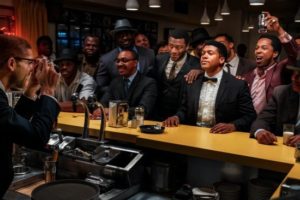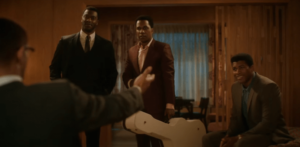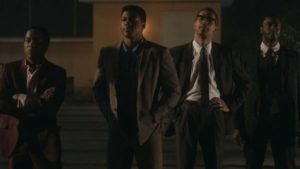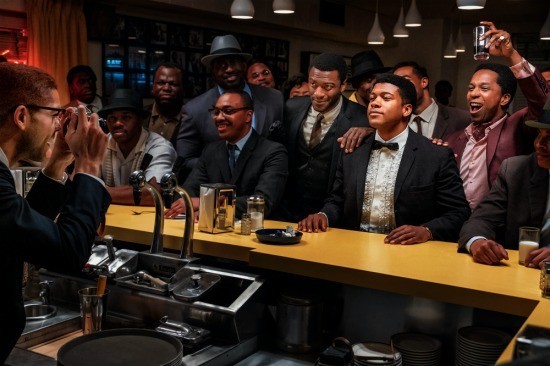Production designer Barry Robison thrives on challenge, as illustrated by the eclectic selection of projects he has worked on over a thirty year career. His recent involvement with TNT’s Snowpiercer brought a graphic novel to life on the small screen, whilst expanding on its feature film companion. Wolverine: Origins, Candyman: Farewell To The Flesh and Hacksaw Ridge also bear his distinctive style. He recently took time to talk to Martin Carr about his involvement with Regina King’s directorial debut One Night In Miami.

This film deals with four very diverse people at a pivotal point in history. What compelled you to sign on?
The script was really wonderful and right off the bat I fell for the period, had a great Skype interview with Regina King and just fell in love with her as well. I was just coming off Amazon’s Dark Tower at this point, so it also required a full one hundred and eighty degree change in terms of approach. To be honest if you look at my career this is the kind of project which resonates with me. Real life drama involving real people so in that respect it shares a lot of similarities with Hacksaw Ridge.
To what extent did the stage play influence your creative choices?
I think they really did and interestingly that night in Miami is so incredibly documented it’s unbelievable. You can go and find images where they are in that restaurant, all around that motel and everything is literally there.
How important was the input of both Regina King and Kemp Powers in shaping any design choices?
To be honest it was Regina all the way, because when I came on board she had already done a quite exhaustive location scout with the producers in New Orleans. So by the time I arrived they had quite a solid understanding of where and how they wanted to shoot; which I thought was interesting. So my involvement started with shaping those choices and changing their choice of motel so it felt correct, not just to the period but more specifically the actual Hampton House itself. Something which was especially important as the building itself is considered a historical landmark. It still exists and is in Miami, so my challenge was how to make a different motel in the middle of nowhere Louisiana look like the Hampton House in Miami. Which proved really challenging as much of the movie, not unlike the play, all takes place in one room. So getting Regina and the DP Tami Reiker to open it up, let it breathe and not have it be this static hundred twenty minute stage play was essential.

Was there any specific research you undertook prior to the beginning of shooting?
Everything about this project is so well documented that I was tearing my hair out, because how far can you really stretch the reality when you can go onto Google search and there it is. You have the Nation of Islam that is what it looks like, so my art director and I were really pushing to give each location that essential sense of reality.
Despite the subject matter One Night In Miami still feels very intimate and personal. How do you think your design choices influenced that?
For us the room was so important and we had to expand on the reality of a motel room. I convinced Regina and Tami to allow me licence to do a few tricks, which would make this location feel almost like a Japanese interior. Where I have these mid-century modern screens that can move, both shutting down and opening up this space giving it a very fluid quality. We then added a room extension which we justified through Malcolm X, who would have been afforded more space due to his position. That was made possible by putting in an arched doorway and constantly suggesting to both Regina and Tami that they shoot through doorways and windows, so we could open up and close down areas where necessary. With these little tricks and a combination of blinds and drapery we were able to really manipulate the room if needed.
The film uses flashback in some short lived but very effective sequences. How do think they shaped this movie and allowed it to breathe in a similar way?
That was the conceit of this film more than the play and they were essential. I don’t mean to belabour the point but this was really low budget, so those scenes felt more like a sketch in my mind. I was never going to fully flesh them out and do a Martin Scorsese, so it became about getting the details right, getting the colours right and then setting them into an environment and letting the effects play where necessary.

Obviously I have to touch on the global situation and ask how it affected things for you this time round.
We started in July of 2019 and then began filming late October so COVID wasn’t a factor at that point. It came towards the end and you could tell because people in our company were sick with something. We all thought it was the basic flu but then COVID hit and hit hard in New Orleans. My art director and I left because we were done, but it was scary, it’s still scary and it’s a mess here.
If you could have a conversation with any one of the main characters in this film, which one would you pick and why?
It would be Malcolm X. He’s an interesting guy with so much depth and so many layers that I would really love to just sit and talk to him about life. What his life was like and basically share my experiences as a white gay man. I would like to hear his thoughts on it.
To be honest I don’t think there are any wrong answers.
Of course you would want to be around Muhammad Ali because he would showboat and he was a showman and all of that, but no, my choice definitely would be Malcolm.
Considering the ongoing impact on the industry can you share a positive experience for you which has come out of this situation?
I would say my relationship with Regina King. I think the world of her, she is an actor’s director as well as a great actress and will become a great director. I fell in love with her during pre-production and while we were shooting and I think she is brilliant.
One Night In Miami is screening for the London Film Festival October 11th and 12th.
Many thanks to Barry Robison for taking the time for this interview.



